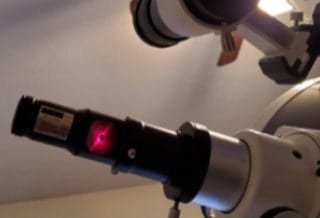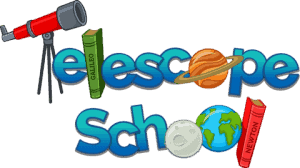Have you ever held off on getting into something because it seemed complicated? Some telescopes look complex and complicated to use, well…
Telescopes themselves are not hard to use. The difficulty comes when magnification increases to the point of needing telescope mounts and tracking abilities for visual stability, ease of locating and maintained visual contact.
Yes, I am saying if you want to look at more than the moon and maybe some planets, it gets more difficult. In essence, the farther and fainter the night sky object you’re trying to see, the harder it gets.
First, let’s find out about the different styles and how hard they are to use. Because the complication comes from the style of telescope and its ability to see or to see more of the night sky.
What is the Easiest Type of Visual Aid to Observe the Night Sky?
Binoculars offer ease of use and offer the stereo view as it were. You see, it is easier to use both eyes to view and see in detail than it is trying to use one eye. Further, they are simple to use, come in an abundance of sizes, and offer versatility. 
A great all-around pair and size you can use is a medium-sized magnification binocular for space, hiking, or anything.
The 15×70 binoculars magnification offers the ability to see the moon, some planets and moons of Jupiter yet still use them to see while hiking, camping, or backyard gazing. This is because it has less magnification and a wider field of view.
You can get serious and add stands (or mounts) to stabilize your view. Here is an excellent all-around binocular mount or support.
If you are going to use a mount for your binoculars, you can jump up to these pair which are only really any good for observing space. Check them out the Celestron 25×70 and larger aperture and magnification binoculars.
Many guys build binocular observing mirrors as well (see pic)
What can you see with binoculars? See the Top 10 Things to See with Binoculars article by clicking here.
What is the Next Easiest Observing Tool on the List?
A refractor telescope on an Alt-Az (altitude azimuth) mount is the next on the list. They can be a great first scope and offer ease of use for a simplistic approach, like a camera stand with tilt and pan. Learn more about an Alt Az mount here.

A refractor is typically always ready to use. Keep the dust off and out of the scope, then just uncover and add your eyepiece and point and view.
The hardest thing here is getting your finderscope aligned to your main telescope. Learn how to do that here.
Reflector Style Telescopes Have an Extra Step; what makes them harder?
Reflector telescopes need to be collimated, this is not difficult once you know how to do it, but it is one more thing to add to the learning curve.
Collimation is the alignment of mirrors to the eyepiece on a reflector telescope. To learn more about collimation, click here.
Tools like the one here make it easy to collimate and keep the scope in collimation. Check the current price and options out here on Amazon.

Reflector telescopes have basically two camps (styles). Newtonian and Dobsonian styles. When the Alt-Az mount is used, collimation is the only added step. However, many Newtonian scopes are mounted on equatorial mounts.
Reflectors are used because they allow for bigger apertures and are less expensive to manufacture in bigger sizes over refractor telescopes. Bigger apertures allow for fainter objects and or higher magnification.
When you are magnified up on a faint object, it will cross the visual realm of your eyepiece quickly. Having slow-motion knobs on an equatorial mount allows you to track it across the night sky.
So it is actually the mount that gets more complicated here, not the telescope per se. Let’s see why that is…
What Makes Telescope Mounts Hard to Use?
Hard to use might not be an accurate claim. What makes the learning curve a little steeper with telescopes and equatorial mounts? Well, let’s find out.
An equatorial mount is perhaps the most difficult to learn, and it is even not that difficult. It is more like a different way of thinking. To check out more about setting up an equatorial mount, click here. In short, however, an equatorial mount needs to be aligned to the polar star.
The North Star (check out this article about the North Star) Polaris is the star in the northern hemisphere. Close to the Sigma Octantis star is the Southern hemisphere polar axis.
Sigma Octantis star is often too faint to see. Most use the distance of the southern cross 4X the distance between the top and bottom stars of the cross (the stars representing the top and bottom).
By aligning to these stars, you create a center point that your telescope can then maintain and track the same arc as the stars through the night sky.
Can One Alleviate The Complication of Polar Alignment Somehow?
With modern GoTo telescopes, you can have them auto-calibrate, in essence, the night sky. You may need to enter your GPS location and the correct time for it to work correctly. Check out the article, Are GoTo Telescopes Worth the Price.
Based on your location and time of day, modern GoTo mounts and scopes will auto find 2 or 3 stars to auto-setup your telescope. Once set up, they then typically have around 40,000 objects you can see on the pre-programmed controller. It is kind of like “click-and-go.”
So, what is complicated with this? It is learning the software. It is easier than it used to be. However, it still has a learning curve, and depending on the user’s ability, it can be complicated or uncomplicated.
Is There A GoTo Mount More Complicated Than Another?
Saying one is more complicated than the other isn’t true. Still, the controls can get more complex for the advantages obtained.
You can even get computerized equatorial mounts so you can mount any telescope you choose. Even multiple telescopes if so desired. They are based on a payload capacity of, say, 40lbs (18kg). See how much telescopes way in this comprehensive article by clicking here.
These mounts have an advantage over, say, a forked mount GoTo scope. This is due to the fork mount style mount maintain a vertical point of view, and the object will twist in your view. Whereas the GoTo equatorial telescope mount will track and keep your view constant.
Another way of describing it is, the fork mount will look like it spins in the eyepiece (like a feature moving from 1 o’clock to 3 o’clock position. Where the computerized equatorial mount will maintain its 1 o’clock point of view.
The main advantage of this is for astrophotography. Your eye and brain can adjust to the slight twist of the object for just observing.
What Makes The GoTo Equatorial Mount More Complicated?
Again, it isn’t the mechanism of the mount but the extra connections and devices to control it.
You will typically have a laptop and software like Stellarium to control the mount. The software may be available from the mount’s manufacture as well. Not that any of these things are complicated by themselves. However, you have control cables, software settings, and a laptop.
Once you get here to this point, astronomers often build a backyard observatory, so the setup is always ready.
Things You Will Most Likely Want To Know For Telescope Viewing
It is basically all the stuff you have to learn. Here is a shortlist of things we didn’t touch on that you will need to know, or at least stumble over at some point in-depth, depending on your observation journey. Luckily we have articles related to most of them.
- Equations for magnification, eye relief, and
- Dark sky,
- Filters and the best ones to use
- Understanding weather
- Barlow Lenses
- Eyepieces
- How Long Will My Telescope Last
Need More?
As you see, it is not the telescope that is complicated; it is the aspects to get the most out of a telescope that makes it more complicated.
Many other articles are linked to within this article. You can get a more in-depth view of the content related to the links. I hope you may take the time to try them out; I look forward to seeing you inside.


